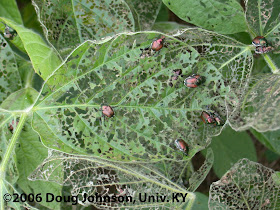A service of the University of Kentucky, College of Agriculture, Food and Environment. Updates are provided by Extension faculty with responsibilities for management of corn, soybean and small grains.
Friday, May 25, 2012
Japanese Beetle Emergence Begins
Doug Johnson, Extension Entomologist
I collected two Japanese Beetle (JB) adults on 23 May in Fulton Co. Kentucky (KY); so emergence of this insect has begun. Likely the early season warm weather and very dry conditions, (at least in western KY) will alter the pest’s emergence pattern. JB is a defoliation pest of both corn and soybeans, and a silk feeding pest in corn. Without question the most important of these tendencies is the corn silk feeding.
JB is normally a common insect in KY during the latter half of June. Conversely, we may be seeing populations emerging a bit early because our very warm late winter and spring temperatures. Having said this, the situation in western KY may be quite different because of a particular adaptation of this pest.
During dry conditions, JB adults are known to delay their emergence from the soil until there is enough soil moisture to insure the survival of their eggs. So, even though the development of the white grub stages and their change into adult beetles may be early, in dry areas the emergence from the soil of the adults may be delayed in favor of rain fall. This delay could cause concentration of the adult emergence into shorter time period giving the appearance of a larger emergence.
JB adults are metallic green and bronze beetles about 1/2“ long. There is a row of white tuffs on each side of the body below the bronze wing covers (Figure-1). They have chewing mouth parts and consume leaf tissue between the leaf veins leaving a lacy appearance. They prefer to feed at the top of the plant and work downward. Their feeding may be dramatic, which leads to the situation where the feeding looks worse than it really is. Nevertheless they can (though not often) reach economically importation levels.
In most cases JB appears when most soybeans are in the middle v stages and contain quite a bit of foliage. In this year, particularly in areas where planting will be delayed for lack of moisture, this relationship may be altered. Certainly younger plants will need more attention while JB is present in large numbers.
Evaluation for treatment is done by estimating defoliation rather than counting beetles. Control should be considered if 30% or more defoliation occurs before bloom, 20% defoliation during the bloom and podfill stages, and 30% defoliation from bloom to pod fill. A more precise evaluation of economic damage may be found in Table 2. Percent Defoliation Charts for Determining Defoliation Required for Economic Injury to Soybeans, found in either ENT-13 Insect Recommendations for Soybeans – 2012 http://pest.ca.uky.edu/EXT/Recs/welcomerecs.html
Or
the insect section of IPM-2 KY IPM Manual for Soybeans.
http://www.uky.edu/Ag/IPM/manuals.htm
In the case that insecticidal control is warranted a list of products labeled for this use may be found in ENT-13 listed above.

No comments:
Post a Comment
Note: Only a member of this blog may post a comment.